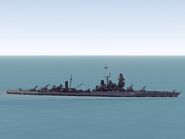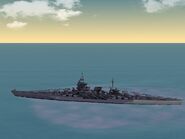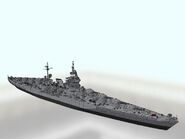Bratstvo i jedinstvo ("Brotherhood and unity")
- Official motto of the SFR Yugoslavia.
The Socialist Federal Republic of Yugoslavia is a one-party federal socialist state located in southeastern Europe, historically formed in the aftermath of the Second World War. The SFR Yugoslavia is nation made up of 5 socialist republics: Bosnia and Herzegovina, Croatia, Macedonia, Montenegro and Serbia. They follow the "Brotherhood and Unity" principle, which focuses on the relations between each republic and embodying the federal constitutions of 1963 and 1974.
Historically, the SFRY can be traced back to 1942 with the formation of the Anti-Fascist Council for the National Liberation of Yugoslavia during WW2. After the war, the SFRY was formed in 1945, originally named the Federal People's Republic of Yugoslavia. With the formation of the FPRY, the monarchy of King Peter II officially ended, and the Yugoslav state became a socialist nation. In 1963, the nation was renamed the Socialist Federal Republic of Yugoslavia. Marshal Josip Broz Tito was the 1st President of Yugoslavia and lead the country from its creation in 1945 until his death in 1980. He was appointed President for Life in 1974 according to the constitution, and is still the de-facto leader of Yugoslavia.
After his death, Yugoslavia became politically and internally unstable. The 1990s saw the SFRY being broken up into 6 different nations, due to the collapse of communism in Europe and the Yugoslav Wars which followed in the mid to late 1990s. Serbia and Montenegro stuck together and become the Federal Republic of Yugoslavia (FRY) in 1992, and become the target of NATO bombing campaigns in 1999. After the Yugoslav Wars, the 6 former Yugoslav states enjoyed a "somewhat" peaceful existence until they became annexed by the Greater German Reich, which soon became known as the Kekistani Empire.
Following the Anti-Imperialist National People's Liberation War as it become know to partisans, the Yugoslav state was once again liberated. The majority of the population called for another SFR Yugoslavia, as they were nostalgic for the old Cold War times under Marshal Tito's guidance. The new Socialist Federal Republic of Yugoslavia was formed in the aftermath of the war in 2017, with all the former states except Slovenia.
Important Figures[]
Yugoslav People's Army (Jugoslovenska narodna armija)[]
| Yugoslav People's Army
Југословенска народна армија Jugoslovenska narodna armija | |
|---|---|
 | |
|
Founded |
1945 |
|
Service branches |
|
|
Active personnel |
771,000 active personnel (2.6 million reserve) |
|
Supreme Commander-in-Chief of the Yugoslav People's Army |
Marshal Zvonimir Larzić |
|
Headquarters |
Belgrade, SFR Yugoslavia |
|
Conscription |
Yes (25-65 voluntary, 18-25 mandatory - 22 month(s) service time) |
|
Anthem |
Jugoslovenska narodna armija medlei ("Yugoslav People's Army Medley") |
The Yugoslav People's Army (YPA), also known as the JNA (Jugoslovenska narodna armija) is the unified armed forces of the Socialist Federal Republic of Yugoslavia. The roots of the JNA can be traced back to 1941, during the Anti-Fascist People's Liberation War of Yugoslavia (WW2). At the time, it was known as the People's Liberation Army of Yugoslavia (NOVJ), the legendary Yugoslav Partisan group which was the armed wing of the Anti-Fascist Council for the National Liberation of Yugoslavia.
During the Anti-Imperialist National People's Liberation War (War against Kekistan), Yugoslavia was occupied by imperialist Kek forces and a second council was formed underground - this time named the Anti-Imperialist Council for the National Liberation of Yugoslavia (AISNOJ), and yet another armed partisan group was formed, acting as the AISNOJ's armed military wing. With the defeat and breakup of the Kekistani Empire, the Socialist Federal Republic of Yugoslavia was reborn (with all former Yugoslav territories, except Slovenia - who opted not to rejoin), and thus the military of the former SFRY, the JNA, was reborn too.
The present Yugoslav People's Army is made up of 4 distinct service branches; the Yugoslav People's Ground Forces, the Yugoslav People's Navy, Yugoslav People's Air Force and the Territorial Defense Forces. Each branch is considered to behighly valued, however the Air Force and Navy are the primary focus. The JNA operates many bases and installations across the Yugoslav mainland, as well as in the high and rocky baltic mountains.
The Yugoslav People's Army is authorized to obey the orders of the Supreme Commander-in-Chief of the Yugoslav People's Army, the President or a Marshal of Yugoslavia. The JNA's commanding officers are made up of Generals and General Armijes (Generals of the Army). The Yugoslav People's Army maintains ties with the Soviet Union's Red Army, as well as friendly links with the People's Army of Vietnam, because Yugoslav and Serbian partisans fought alongside both during the Anti-Imperialist National People's Liberation War against the Kekistani Empire.
The de-facto motto of the JNA is Smrt fašizmu, sloboda naroda! ("Death to Fascism, Freedom to the people!"), the motto of the Yugoslav Partisans during the Second World War. However, with the absence of fascist governments in the modern world, "fascism" is usually replaced with "imperialism" (imperijalizam) - Smrt imperijalizam, sloboda naroda!
[]
Destroyers[]
Frigates[]
Heavy Cruisers[]
Corvettes[]
Missile boats[]
Aircraft Carriers[]
Battleships[]
Yugoslav People's Ground Forces (Jugoslovenske narodne snage)[]
Yugoslav People's Air Force (Jugoslovenske narodne vazduhoplovne snage)[]
Fighters[]
[]
DESTROYERS
- Partizan-class - 15
- Partizan II-class - 30
- Partizan II-M-class - 35
- Partizan II-class - 30
FRIGATES
- Vukovar-class - 15
- Dubrovnik-class - 15
- Pionir-class - 15
- Pionir II-class - 25
HEAVY CRUISERS
- Kozara-class - 5
- Kozara M-class - 5
CORVETTES
- Zaštitnik-class - 20
MISSILE BOATS
- Luks-class - 25
- Luks II-class - 30
AIRCRAFT CARRIERS
- Titograd-class - 3
BATTLESHIPS
- Grad Sarajevo - 3
Army roster[]
TBA
Air Force roster[]
FIGHTERS
- Zastava L-35 - 100
Foreign Relations[]
Allies
Territories
 Socialist Republic of Bosnia and Herzegovina
Socialist Republic of Bosnia and Herzegovina Socialist Republic of Croatia
Socialist Republic of Croatia Socialist Republic of Macedonia
Socialist Republic of Macedonia Socialist Republic of Montenegro
Socialist Republic of Montenegro Socialist Republic of Serbia
Socialist Republic of Serbia
Diplomatic relations
- None, as of now.
Enemies
- None. (official)
 Kekistani Empire (former, de-facto)
Kekistani Empire (former, de-facto)
Trade Agreements
 Union of Soviet Socialist Republics [MILITARY & DOMESTIC]
Union of Soviet Socialist Republics [MILITARY & DOMESTIC]



























